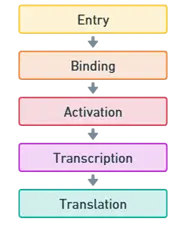- Mechanism of hormone action involves complex biochemical processes that allow hormones to regulate various physiological functions in the body.
- Hormones are chemical messengers secreted by endocrine glands into the bloodstream, where they travel to target cells or organs to exert their effects.
- Mechanism of Hormone Action can be broadly classified into two types based on their chemical nature and receptor location: lipid-soluble (steroid hormones and thyroid hormones) and water-soluble (protein/peptide hormones and amine hormones) hormones.
Here’s how these mechanisms work:
Lipid-soluble Hormones (Steroid and Thyroid Hormones)
- Lipid-soluble hormones easily pass through the cell membrane of the target cell due to their lipophilic nature.
- Their receptors are typically located inside the cell, either in the cytoplasm or the nucleus.
Advertisements
Mechanism:

- Entry: The hormone diffuses through the plasma membrane of the target cell.
- Binding: It binds to a specific intracellular receptor, forming a hormone-receptor complex.
- Activation: The binding alters the receptor’s shape, allowing it to enter the nucleus (if it’s not already there) and bind to specific DNA sequences.
- Transcription: This binding to DNA promotes or inhibits the transcription of specific genes, leading to an increase or decrease in the production of mRNA.
- Translation: The mRNA is translated into specific proteins by ribosomes in the cytoplasm, leading to changes in cell function.
Advertisements
Water-soluble Hormones (Protein/Peptide and Amine Hormones)
- Water-soluble hormones cannot easily cross the lipid bilayer of the cell membrane.
- Thus, their receptors are located on the surface of the target cells.
Mechanism:

Advertisements
- Binding: The hormone binds to its receptor on the cell surface, which is specific to that hormone.
- Signal Transduction: This binding activates a signal transduction pathway inside the cell, often involving second messengers like cyclic AMP (cAMP), inositol triphosphate (IP3), or calcium ions.
- Cascade Effect: The activation of the second messenger triggers a series of biochemical reactions inside the cell.
- Effect: These reactions lead to various cellular responses, such as the activation of enzymes, opening of ion channels, or changes in gene expression, ultimately altering the cell’s function.

